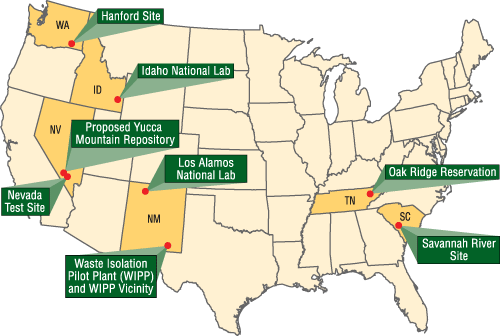The US Senate Energy Committee in late April issued a “discussion draft” of comprehensive legislation on how atomic wastes will be managed. Legislators draft bills routinely, but this is an unusual case for several reasons. For one, it has bipartisan backing including Senators Feinstein (D-CA), Wyden (D-OR), Murkowski (R-AK) and Alexander (R-TN). (Senators Feinstein and Alexander also each issued alternative proposals.) For two, and more surprising, the senators are inviting public comments on their draft. The deadline is May 24, and comments may be submitted electronically, through the committee’s link.
Northwesterners should pay attention.
Cascadia is home to federal atomic facilities at Hanford and eastern Idaho, where much work remains to be done. Each site is heavily contaminated with atomic and chemical wastes from past weapons-connected operations, and the US Department of Energy (DOE) is carrying out environmental cleanup in both locations. Previous Sightline posts have covered each site. At Hanford, state and local officials are most concerned about “high level” radioactive wastes, in the form of some 50 million gallons in huge underground tanks, wastes that remain in liquid form today. Among other contaminants, Idaho holds liquid and solid “transuranic” wastes containing plutonium or other elements of higher atomic numbers than uranium. Elected officials have been fighting the federal government for decades, trying to get those wastes stabilized and moved out of state.
A dilemma for Hanford, eastern Idaho, and similar sites across the country is that the contamination already there makes them targets for receiving even more when federal officials go looking for locations to store chemical or atomic wastes. In fact, in 2007, DOE identified eight federal facilities, including Hanford and the Idaho nuclear site, as recipient candidates for one particular category of atomic wastes produced at federal facilities and by commercial atomic plants. This is the map of the eight candidate locations:

Of potential concern for Cascadia is whether the two Northwest sites might be the recipients of large radioactive inventories of waste from commercial facilities, which are expected to generate the majority of these wastes in the future.
To understand how we got here, a little context is in order.
Cleanup at each of the major former atomic weapons facilities is influenced by particular Site Specific Advisory Boards (SSABs), which provide recommendations for cleanup at each facility. In November 2004, SSAB chairs at major sites sent a joint letter to DOE, recommending that the department sponsor a National Stakeholder Forum on Waste Disposition, “to produce technically sound, fiscally responsible, politically acceptable, sustainable, and comprehensive solutions to DOE’s system-wide waste and material disposition challenges.” The letter mentioned “multiple legal barriers to shipping” atomic wastes and it was clearly responding to political currents of the moment. At the time, voters in Washington State had approved a ballot measure prohibiting introduction of new wastes into Hanford (although the measure was subsequently overturned by the courts). And a proposed federal site at Yucca Mountain, Nevada, was facing legal challenges and opposition from Nevada elected officials over its designation as a national radioactive waste repository for both commercial and federal atomic wastes.
The Obama administration abandoned further proceedings on Yucca Mountain, and in 2010 chartered a Blue Ribbon Commission on America’s Nuclear Future, to make recommendations on the management of atomic wastes, commercial and federal. (Full disclosure, the drafter of this post previously submitted comments to the Blue Ribbon Commission, through Washington Physicians for Social Responsibility in June 2010, prior to the Fukushima atomic accident in March 2011. To see those comments and signers click on this link.)
The Blue Ribbon Commission issued its Final Report and Recommendations to the Secretary of Energy in January 2012, recommending eight key elements in a strategy for proceeding. Number one was a “new, consent-based approach to siting future nuclear waste management facilities.” It was a welcome departure from what had been characterized as a “decide, announce, defend” strategy that DOE had used in the past.
The senate draft legislation is designed to implement the Blue Ribbon Commission’s recommendations, and in keeping with the new consent-based approach they invite comments from all, including Commission members and private citizens. Procedures for commenting, a page to submit an executive summary of one’s comments, and seven other questions the senators would especially like commenters to address can be found by clicking on this link.
Federal agencies by law are required to solicit public comments on draft proposals or options before making a final decision on major issues. But it is rare for Congressional committees to seek public comment on draft legislation, and the senators should be commended for inviting citizen comment on their discussion draft. The invitation sets a new precedent for public participation, and the electronic age makes it relatively easy for people to comment. You can make your voice heard at the senate committee web page, and we repeat the link here.
John Abbotts is a former Sightline research consultant who occasionally submits material that Sightline staff turn into blog posts.

Comments are closed.